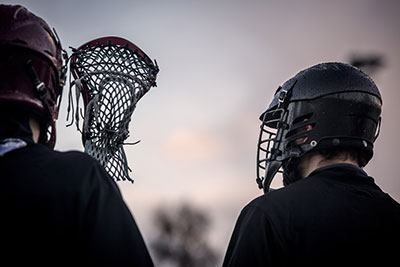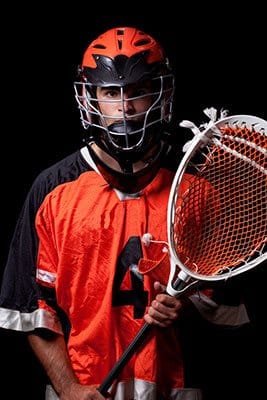Are you an up-and-coming lacrosse player looking for the ultimate guide to making sure you're outfitted with properly fitting and protective gear? Then you need to know about helmet tilt!
Even if you don't understand it yet, helmet tilt is crucial to lacrosse safety equipment - but don't sweat it. Our comprehensive guide has got your back.
In this blog post, we'll show all players exactly what a lacrosse helmet tilt is and why getting it just right before hitting the field is important. We'll also provide tips and techniques whether or not you're experienced in adjusting helmets.
More...
Take Away Key Points:
Learning how lacrosse players properly tit lacrosse helmets
If you want to learn more about how a player tilts his helmet correctly while playing lacrosse, here is the best guide to teach you all the steps.
What does tilt mean in lacrosse?
Lacrosse helmets provide essential protection for players on the field. One of the features a lacrosse helmet must have is tilt. Tilt is a common term used in the lacrosse community.
Tilt refers to how much the helmet can move forward or back relative to your head shape and size. Adjustable tilt allows each athlete to create a tailored fit, ensuring optimal safety and comfort.
Typically, helmets offer four different levels of tilt, so you're sure to find one that fits properly for maximum protection and impact absorption at all times. Ensuring you have the correct amount of tilt in your helmet is vital to feel secure and confident when playing the game you love.

How can you tilt the helmet correctly?
Get a perfect fit with lacrosse helmets - they are highly adjustable. You will need to adjust the chinstrap and helmet cushioning, but it won't take long since you will get the hang of it soon enough. The tilt of your helmet is linked to your head structure and the specific helmet you use.
Keep in mind that while helmet tilt does have an impact on performance and safety, there's much less influence than some might think.
Many lacrosse players joke about it as they believe only pros use high tilt while low tilt is for newcomers. So let's check out different levels of tilt and what other players might think when they see you!
How do lacrosse players know how much tilt they need?
Lacrosse players must find the perfect amount of helmet tilt that provides comfort when on the field and optimum protection from impacts.
To get an idea of the optimal size and tilt while on the lacrosse field, have them sit with their head in a neutral position and look straight ahead. The angle of the helmet should match this angle, allowing for a more natural fit to provide comfort throughout any duration of playing.
Another helpful hint is to have your helmet snug enough so you can twist it slightly off of your head without it falling off. Ultimately, lacrosse players need to experiment to achieve the best-fitting helmet for them as everyone's head shape and size are different.
What are different tilt levels?
Below you can find the most popular helmet tilt levels to protect the player's head from rough game and injuries. The tilt is relative to the player's eye level. The most common tilt types include:
1. No tilt
It is not recommended to wear a lacrosse helmet without any tilt. It is generally perceived as you do not know how to wear the helmet properly. Without it, your helmet won't be able to block out the sun and could negatively impact safety.
The third helmet bar will be in your line of vision, and you would need to look at or below it to see anything. This choice of lack of tilt might make other players believe that you are a newcomer who doesn't know how to put their helmets on correctly - which is incorrect.
2. Low tilt
Low-tilt helmets are slightly better than no-tilt ones, but the visor will be too far from your eyes to provide shade. As a result, the sun's rays will directly shine on you and cause the second bar syndrome.
Other players will likely make fun of you as it indicates you aren't a seasoned lacrosse veteran. Wearing your helmet in such a manner suggests novice-level experience. Also, your helmet visor will be too far away from your eyes, and you cannot do anything.
When you wear low tilt, the helmet tilts forward so that you can see through the second and third bars. And such a position of the helmet visor might not be comfortable.

3. Medium to high tilt
Medium tilt reduces the higher risk of injuries caused by the lacrosse ball. You can find the best visibility and safety if you play lacrosse with medium tilt.
Most lacrosse players choose medium tilt as the most comfortable one. They are safe as the helmet face mask sits correctly on their face, so nothing can go in between. On the other hand, the medium tilt level blocks the sun and other obstacles, providing you with more safety standards, including errant shots and blindside checks.
Most other players will have medium helmet tilt and not notice or comment on your choice. Medium helmet tilt is seen as the most professional when playing lacrosse.
4. High tilt
Having your helmet tilted high may restrict your field of vision and block out a lot of the environment. It can give off an impression that you are a pro or someone is trying to boast. The player tilts the helmet forward to see through the top two bars of the helmet face mask.
High-tilt lacrosse helmets are not recommended, as the visor can obstruct your view of the field. It is also seen as an unprofessional look, even though it may be comfortable for some players. When wearing a high tilt helmet, you can see through the first bar but not the second.
Generally, opinions on this vary; some think it looks fantastic, while others think it's silly. As it is quite a contentious subject in lacrosse, be mindful if you decide to try out the look.
Why do players talk about tilt so much?
The slang term is popular among lacrosse players as they often like to look fashionable and stylish while playing well. Some may opt for a higher helmet tilt, although it has various drawbacks, as wearing a helmet with no or low tilt could be seen as a sign of being inexperienced. The safest option is to go with medium tilt if one wants to avoid such assumptions.
How does the helmet tilt affect the safety of players?
Safety is an important factor to consider when it comes to helmet tilt. Having a high tilt can limit vision, lead to collisions, and leave you vulnerable to blindside checks and shots.
In addition, helmets protect players from all kinds of injuries and keep them optimal, which is especially important for youth players.
Too low of a tilt, on the other hand, puts your chin at risk and may cause your helmet to become dislodged in certain situations; the mask should cover your chin for adequate protection.
When a player adjusts the helmet backward, he can see through the third and lower bars of the face mask. However, the helmet can also pop off and cause severe injuries to players. When tilted forward, the helmet and the face mask will not impede the vision of the field.
What is the best level of tilt?
The best solution for optimal safety and comfort is an intermediary tilt level, which is why the pros prefer it. However, every person's perfect helmet tilt will be slightly different, so it's important to find what works best for you.
How to properly adjust the helmet tilt? A step-by-step guide
To properly adjust the helmet tilt, begin by putting it on and ensuring it fits comfortably (not too tight or loose). You can add or remove the interior padding to ensure the best fit.
If needed, use a clip on the back of the helmet or add/remove padding via Velcro. You can skip this step if your helmet does not have an adjustable helmet clip.
Then, button up the chin strap and adjust your tilt to what feels comfortable while ensuring it doesn't tilt sideways. When finished with the top straps, do the same for the bottom straps. Thus, you will adjust the helmet and the face mask for the best use.
Frequently Asked Questions
Why do lacrosse players tilt their helmets?
Lacrosse players tilt their helmets for a variety of reasons. One of the most common reasons is to improve visibility while playing. Tilting the helmet allows the player to see more of the field, which can be especially helpful when locating an open teammate or spotting an opponent's position.
Additionally, some players tilt their helmets for comfort and style. Tilting the helmet can help reduce pressure on the head and make it easier to wear for long periods. It can also give players a unique look that helps them stand out from other players on the field.
What does tilt mean in lacrosse?
Tilt is a term used in lacrosse to describe the angle of a player's helmet face mask about their eye level. The levels of tilt can range from no tilt to low, medium, and high.
With a high tilt, the helmet tilts forward so that the player sees through the top bars of the face mask.
A low tilt means you tilt the helmet backward so that you see through the lower second and third bars of the face mask.
Tilt is an important factor for players as it affects their vision on the field and can help them perform better.
How do you get more tilt on a lacrosse helmet?
Getting the correct tilt on a lacrosse helmet is vital for both comfort and safety. To get more tilt on your helmet, you can adjust the straps, add additional padding to the helmet's interior, or loosen or tighten the adjustable helmet clip. It's also important to ensure the visor is correctly aligned with your forehead.
To ensure a perfect fit, start by adjusting the straps to be snug but not too tight. Then pull the front of the helmet downward until it rests roughly ½" - 1" above your eyebrow line. Finally, adjust the adjustable helmet clip to get your desired level of tilt. You can choose from no tilt, low, medium, and high levels of tilt.

How tight should a lacrosse helmet be?
A helmet should be snug but not too tight. It should fit the level on your head and provide firm and uniform pressure all around without causing any unnecessary pressure. The chinstraps should be firmly buckled and adjusted so that the helmet does not move when you shake your head.
To ensure a proper fit, use the sizing chart the manufacturer provided or consult a professional to determine the best size for you.
How do you fix a tilt on a lacrosse helmet?
If you want to fix a tilt on a lacrosse helmet, the first step is to adjust the straps. This will help to ensure that the helmet fits properly and securely. You can also add additional padding to the inside of the helmet for extra comfort and support. Finally, make sure you select the correct size helmet using a sizing chart.
Conclusion
Lacrosse helmet tilt is crucial for preventing injuries and making sure the players are protected. Look for a helmet that has been tested and approved by experts.
You can also find some good tips online on properly fitting the helmets. So, if you want your kids to wear their lacrosse helmets properly, make sure you get a helmet that tilts.
